Venus Orbiter Imaging Radar
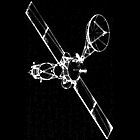 A working group of scientists and engineers at NASA submit an official proposal for a spacecraft using synthetic aperture radar to map the surface of the planet Venus. Conceived as a mission that could be launched from a Titan IIIe or from the space shuttle, both of which still exist only on the drawing board, Venus Orbiter Imaging Radar (or VOIR) is designed to offer extensive mapping of Venus at a resolution much better than the coarse resolution of radar signals originating from Earth-based radio astronomy facilities such as Arecibo, along with such cutting-edge technologies as stereoscopic imaging and solar electric propulsion. Work on this mission will continue through the early 1980s, at which point it is cancelled by NASA and replaced by a cheaper mission intended to achieve the same goals, Magellan.
A working group of scientists and engineers at NASA submit an official proposal for a spacecraft using synthetic aperture radar to map the surface of the planet Venus. Conceived as a mission that could be launched from a Titan IIIe or from the space shuttle, both of which still exist only on the drawing board, Venus Orbiter Imaging Radar (or VOIR) is designed to offer extensive mapping of Venus at a resolution much better than the coarse resolution of radar signals originating from Earth-based radio astronomy facilities such as Arecibo, along with such cutting-edge technologies as stereoscopic imaging and solar electric propulsion. Work on this mission will continue through the early 1980s, at which point it is cancelled by NASA and replaced by a cheaper mission intended to achieve the same goals, Magellan.

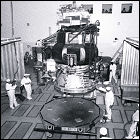 NASA informs the project managers of the Galileo and Magellan interplanetary probes – both of which were due to be launched via space shuttle – that their planned launches are obviously off the schedule due to the destruction of space shuttle Challenger and her crew. Further changes in the shuttle program in the wake of the tragedy will have far-reaching effects, including the cancellation of propulsion modules that would have allowed, for example, Galileo to be put on a direct trajectory toward Jupiter. The Galileo mission plan will undergo significant changes, including the loss of a planned visit to asteroid 29 Amphitrite, and both missions will eventually begin from the cargo bay of space shuttle missions in 1989.
NASA informs the project managers of the Galileo and Magellan interplanetary probes – both of which were due to be launched via space shuttle – that their planned launches are obviously off the schedule due to the destruction of space shuttle Challenger and her crew. Further changes in the shuttle program in the wake of the tragedy will have far-reaching effects, including the cancellation of propulsion modules that would have allowed, for example, Galileo to be put on a direct trajectory toward Jupiter. The Galileo mission plan will undergo significant changes, including the loss of a planned visit to asteroid 29 Amphitrite, and both missions will eventually begin from the cargo bay of space shuttle missions in 1989.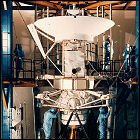 NASA has to borrow some of its own spare parts back from the Smithsonian Air & Space Museum to begin engineering mock-up work on the unmanned Venus radar mapping probe Magellan. As JPL works on modifications to a backup central bus component left over from the Voyager program, a physical copy of that bus from an engineering backup of the Voyager spacecraft is loaned back to JPL, shipped to Pasadena from Washington, D.C. (This loan saves JPL the trouble of building another replica of the bus, the central hub of the spacecraft containing its computer and electrical systems, which could add significant cost to the preparations.) The real Magellan, due to be launched soon after the currently grounded space shuttle program resumes, will cut costs by incorporating unused backup equipment from its predecessors, including a Voyager central bus and high-gain antenna, a medium-gain antenna spare from the Mariner missions to Mars, and a Galileo data handling system.
NASA has to borrow some of its own spare parts back from the Smithsonian Air & Space Museum to begin engineering mock-up work on the unmanned Venus radar mapping probe Magellan. As JPL works on modifications to a backup central bus component left over from the Voyager program, a physical copy of that bus from an engineering backup of the Voyager spacecraft is loaned back to JPL, shipped to Pasadena from Washington, D.C. (This loan saves JPL the trouble of building another replica of the bus, the central hub of the spacecraft containing its computer and electrical systems, which could add significant cost to the preparations.) The real Magellan, due to be launched soon after the currently grounded space shuttle program resumes, will cut costs by incorporating unused backup equipment from its predecessors, including a Voyager central bus and high-gain antenna, a medium-gain antenna spare from the Mariner missions to Mars, and a Galileo data handling system.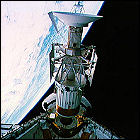 Space Shuttle Atlantis lifts off on a four-day mission to launch the long-delayed interplanetary probe Magellan, which is sent to Venus via an Interial Upper Stage booster module. For the first time, one of a shuttle’s five onboard computers fails and is replaced in an in-orbit repair procedure. Aboard Atlantis for this flight are Commander David Walker, Pilot Ronald Grabe, and mission specialists Norm Thagard, Mary Cleave and Mark Lee. The launch of Magellan, a mission originally conceived in 1972, marks the beginning of the first American interplanetary mission since 1977.
Space Shuttle Atlantis lifts off on a four-day mission to launch the long-delayed interplanetary probe Magellan, which is sent to Venus via an Interial Upper Stage booster module. For the first time, one of a shuttle’s five onboard computers fails and is replaced in an in-orbit repair procedure. Aboard Atlantis for this flight are Commander David Walker, Pilot Ronald Grabe, and mission specialists Norm Thagard, Mary Cleave and Mark Lee. The launch of Magellan, a mission originally conceived in 1972, marks the beginning of the first American interplanetary mission since 1977.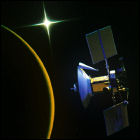 Launched via space shuttle in May 1989, the long-delayed Magellan space probe reaches the planet Venus after an unusually long voyage (15 months) and begins an orbital insertion maneuver. Where most missions to Venus have reached the planet in only a few months, Magellan has had to make do without the more powerful Centaur liquid-fueled booster stage, resulting in a journey of a year and three months. (The Centaur upper stage had been cancelled after the Challenger disaster because it was felt that carrying an additional liquid-fueled rocket in a shuttle cargo bay was too risky.) Magellan is placed into an elliptical orbit, completely circling Venus every three hours, where it will conduct high-resolution radar mapping of the surface at the closest point in its orbit, and transmitting the resulting data to Earth while furthest from Venus. The first phase of the mapping mission will last through 1991.
Launched via space shuttle in May 1989, the long-delayed Magellan space probe reaches the planet Venus after an unusually long voyage (15 months) and begins an orbital insertion maneuver. Where most missions to Venus have reached the planet in only a few months, Magellan has had to make do without the more powerful Centaur liquid-fueled booster stage, resulting in a journey of a year and three months. (The Centaur upper stage had been cancelled after the Challenger disaster because it was felt that carrying an additional liquid-fueled rocket in a shuttle cargo bay was too risky.) Magellan is placed into an elliptical orbit, completely circling Venus every three hours, where it will conduct high-resolution radar mapping of the surface at the closest point in its orbit, and transmitting the resulting data to Earth while furthest from Venus. The first phase of the mapping mission will last through 1991.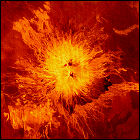 NASA’s Magellan space probe, orbiting the planet Venus, has completed a checkout phase and begins its primary mapping mission, intended to gather data of the Venusian surface as high resolution as one kilometer per pixel. Rather than using visible light – which would yield only images of Venus’ dense clouds – Magellan uses radar to map the planet’s blistering hot surface. Launched in May 1989 via space shuttle, Magellan will continue mapping the surface of Venus through May 1991.
NASA’s Magellan space probe, orbiting the planet Venus, has completed a checkout phase and begins its primary mapping mission, intended to gather data of the Venusian surface as high resolution as one kilometer per pixel. Rather than using visible light – which would yield only images of Venus’ dense clouds – Magellan uses radar to map the planet’s blistering hot surface. Launched in May 1989 via space shuttle, Magellan will continue mapping the surface of Venus through May 1991.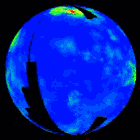 NASA’s Magellan space probe, which has been mapping the planet Venus from orbit since September 1990, completes the first phase of its map-making mission, completing radar imaging of more than 80% of the planet’s surface. NASA authorizes an extended mission, lasting into 1992, which will yield a more complete map of the Venusian surface, including its polar regions.
NASA’s Magellan space probe, which has been mapping the planet Venus from orbit since September 1990, completes the first phase of its map-making mission, completing radar imaging of more than 80% of the planet’s surface. NASA authorizes an extended mission, lasting into 1992, which will yield a more complete map of the Venusian surface, including its polar regions.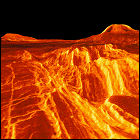 The third phase of data gathering begins for NASA’s Magellan unmanned space probe, launched via space shuttle in 1989 and currently orbiting the heavily-clouded planet Venus. Using radar to peer through the planet’s dense clouds, Magellan has now mapped 96% of the planet’s surface, and will now spend much of the remainder of 1992 filling in details in regions it has missed, as well as re-scanning some regions of Venus stereoscopically, allowing for three-dimensional terrain reconstruction.
The third phase of data gathering begins for NASA’s Magellan unmanned space probe, launched via space shuttle in 1989 and currently orbiting the heavily-clouded planet Venus. Using radar to peer through the planet’s dense clouds, Magellan has now mapped 96% of the planet’s surface, and will now spend much of the remainder of 1992 filling in details in regions it has missed, as well as re-scanning some regions of Venus stereoscopically, allowing for three-dimensional terrain reconstruction.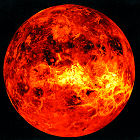 NASA’s unmanned Magellan space probe, having completed three extensive campaigns of mapping the surface of Venus from orbit with cloud-penetrating radar, begins a fourth mission phase, this time sending constant engineering telemetry to Earth, where measurements of Doppler shift in the signal received allows Earthbound scientists to map the gravitational field of Venus. Magellan’s map-making days are over, having achieved a 98% complete map of the cloud-shrouded planet that it has been orbiting since 1990.
NASA’s unmanned Magellan space probe, having completed three extensive campaigns of mapping the surface of Venus from orbit with cloud-penetrating radar, begins a fourth mission phase, this time sending constant engineering telemetry to Earth, where measurements of Doppler shift in the signal received allows Earthbound scientists to map the gravitational field of Venus. Magellan’s map-making days are over, having achieved a 98% complete map of the cloud-shrouded planet that it has been orbiting since 1990.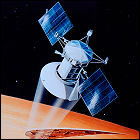 To increase the accuracy of its gravity map of the planet Venus, NASA’s unmanned space probe Magellan conducts the first experimental aerobraking maneuvers to alter the shape its orbit to a near-circular shape. By dipping Magellan into the upper layers of the Venusian atmosphere, the spacecraft is slowed and its orbit is changed, but it is kept far enough from the denser lower layers of the atmosphere to avoid re-entry. Aerobraking will become more commonly used by future space probes at the planet Mars.
To increase the accuracy of its gravity map of the planet Venus, NASA’s unmanned space probe Magellan conducts the first experimental aerobraking maneuvers to alter the shape its orbit to a near-circular shape. By dipping Magellan into the upper layers of the Venusian atmosphere, the spacecraft is slowed and its orbit is changed, but it is kept far enough from the denser lower layers of the atmosphere to avoid re-entry. Aerobraking will become more commonly used by future space probes at the planet Mars.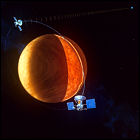 NASA’s Magellan space probe, still orbiting Venus since 1990, enters a phase of slightly riskier experiments, dipping its solar panels into the upper reaches of the Venusian atmosphere and firing its reaction control engines to keep from spinning out of control. This allows for studies of the composition of Venus’ atmosphere, as well as studies of the vehicle’s behavior as it resists atmospheric friction. The results of the “windmill” experiment inform the design of future Mars probes which will need to aerobrake to slow down and enter the Martian atmosphere.
NASA’s Magellan space probe, still orbiting Venus since 1990, enters a phase of slightly riskier experiments, dipping its solar panels into the upper reaches of the Venusian atmosphere and firing its reaction control engines to keep from spinning out of control. This allows for studies of the composition of Venus’ atmosphere, as well as studies of the vehicle’s behavior as it resists atmospheric friction. The results of the “windmill” experiment inform the design of future Mars probes which will need to aerobrake to slow down and enter the Martian atmosphere.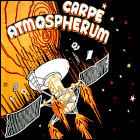 NASA’s Magellan space probe, orbiting Venus since 1990, is retired by entering the atmosphere of the planet whose surface it has mapped. With its power systems exhibiting signs of age and wear, Magellan has been intentionally dropped into an orbit low enough to allow its destruction in Venus’ dense atmosphere. Launched in 1989 via space shuttle, Magellan mapped the planet’s surface with cloud-penetrating radar, covering 98% of the Venusian surface, at least 1/5 of it with stereoscopic imaging allowing for accurate 3-D reconstruction of Venus’ surface features.
NASA’s Magellan space probe, orbiting Venus since 1990, is retired by entering the atmosphere of the planet whose surface it has mapped. With its power systems exhibiting signs of age and wear, Magellan has been intentionally dropped into an orbit low enough to allow its destruction in Venus’ dense atmosphere. Launched in 1989 via space shuttle, Magellan mapped the planet’s surface with cloud-penetrating radar, covering 98% of the Venusian surface, at least 1/5 of it with stereoscopic imaging allowing for accurate 3-D reconstruction of Venus’ surface features.